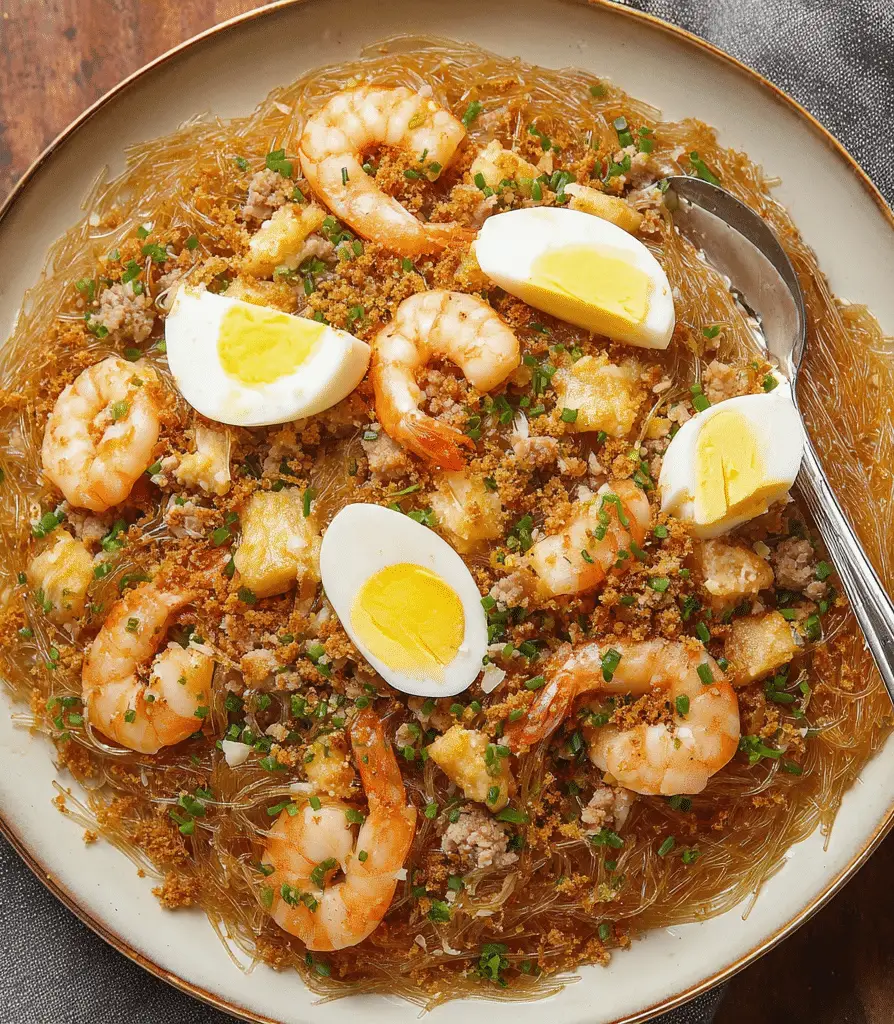The richness of Pancit Palabok comes from its deeply savory shrimp and pork sauce paired with delicate rice noodles and a parade of flavorful toppings like crushed chicharrón, hard-boiled eggs, fried tofu, and crispy garlic. Each bite offers contrast — the creamy sauce, the chewy noodles, and the crunch from the toppings all work in perfect harmony.
This classic Filipino noodle dish is often reserved for celebrations, but it’s simple enough to make on a busy weeknight. Served with a squeeze of calamansi or lemon for brightness, it’s a satisfying and soulful meal that will transport you straight to the streets of Manila or a bustling Filipino family gathering.
Full Recipe
Ingredients:
For the sauce:
-
2 tablespoons annatto seeds (or annatto powder)
-
3 tablespoons oil
-
5 cloves garlic, minced
-
1 small onion, finely chopped
-
1/2 pound ground pork
-
1 tablespoon fish sauce
-
2 cups shrimp stock (or water with bouillon)
-
1/2 cup water
-
2 tablespoons cornstarch (dissolved in 1/4 cup water)
-
Salt and pepper to taste
For the toppings:
-
1/2 cup cooked shrimp, peeled and deveined
-
2 hard-boiled eggs, sliced
-
1/2 cup crushed chicharrón (pork rinds)
-
1/2 block firm tofu, fried and cubed
-
1/4 cup scallions, chopped
-
1/4 cup fried garlic
-
Calamansi or lemon wedges
For the noodles:
-
8 ounces rice noodles (bihon)
Directions:
-
Soak rice noodles in warm water for 15-20 minutes or until softened. Drain and set aside.
-
In a small pan, heat oil and add annatto seeds. Let them infuse the oil for 1-2 minutes, then strain out seeds and discard. Set annatto oil aside.
-
In a skillet, heat annatto oil. Sauté garlic and onions until fragrant.
-
Add ground pork and cook until lightly browned. Season with fish sauce.
-
Pour in shrimp stock and bring to a simmer. Add dissolved cornstarch while stirring until the sauce thickens. Season with salt and pepper.
-
Boil water in a pot, add soaked rice noodles, and cook for 1-2 minutes or until tender. Drain well.
-
To assemble, place noodles on a serving platter. Pour sauce over the noodles.
-
Top with shrimp, tofu, eggs, chicharrón, scallions, and fried garlic.
-
Serve with calamansi or lemon wedges on the side.
Prep Time: 15 minutes | Cooking Time: 25 minutes | Total Time: 40 minutes
Kcal: 420 kcal | Servings: 4 servings
The Rich History of Pancit Palabok
Pancit Palabok is more than just a noodle dish—it’s a cultural icon in the Philippines that has stood the test of time. The word pancit refers to noodles, a culinary influence brought by Chinese traders centuries ago, and palabok describes the rich, flavorful, orange-hued sauce made with shrimp and annatto. This dish represents a beautiful fusion of cultures and is one of the many regional variations of pancit found across the archipelago. Palabok, with its vibrant color and distinct layers of toppings, is often served during Filipino celebrations like birthdays, fiestas, and holidays, symbolizing long life and prosperity.
Why Pancit Palabok is So Unique
What makes Pancit Palabok truly stand out among noodle dishes is the complexity and depth of its flavor profile. The sauce is made with shrimp stock and thickened with cornstarch, delivering a silky texture and rich umami taste. Annatto oil gives the dish its signature orange color and subtly earthy tone. But what elevates Palabok are its generous toppings: from tender shrimp and savory ground pork to crispy chicharrón, fried tofu, hard-boiled eggs, and a sprinkling of scallions and fried garlic. Each topping adds its own layer of flavor and texture, creating an incredibly satisfying culinary experience.
Cultural Significance and Occasions
In Filipino culture, noodles are always associated with celebration and abundance. Pancit Palabok is a staple at many gatherings, often served as the centerpiece on buffet tables. Unlike other noodle dishes like Pancit Bihon or Canton, which can be stir-fried in bulk, Palabok is typically assembled just before serving. This ensures the noodles remain springy and the toppings stay fresh and crisp. You’ll often find this dish at Filipino birthday parties, holiday banquets, or town fiestas. It’s the kind of dish that brings people together, made to be shared and enjoyed with loved ones.
A Celebration of Texture and Flavor
One of the most beloved aspects of Pancit Palabok is its interplay of textures. You get the soft, chewy rice noodles, silky and savory sauce, tender shrimp, and crispy bits of pork cracklings and garlic. Then there’s the contrast of the rich sauce with the brightness of freshly squeezed calamansi or lemon juice. The fried tofu adds a plant-based, spongy texture that absorbs the sauce beautifully, while hard-boiled eggs give a comforting creaminess. It’s a dish designed to hit every note—salty, umami, garlicky, crispy, creamy, and tangy.
Modern Takes and Variations
While the traditional Pancit Palabok is beloved in its classic form, modern home cooks and chefs have begun creating new versions that suit contemporary preferences and dietary needs. Some replace the pork with plant-based protein for a vegetarian twist. Others use smoked fish flakes (tinapa), which adds an extra punch of savory flavor. Instant Palabok kits are also popular among Filipinos abroad, offering a convenient way to make this dish without starting from scratch. There’s even a version called Pancit Luglug from the region of Pampanga, which uses thicker noodles and a more robust sauce.
Health and Nutrition Insights
Though traditionally indulgent, Pancit Palabok can be modified to align with healthier lifestyles. Using less oil and incorporating lean protein or tofu can reduce the calorie count. Since it uses rice noodles, it’s naturally gluten-free, making it a suitable option for those with dietary restrictions. The addition of eggs and shrimp adds protein, while toppings like scallions and garlic contribute essential vitamins and antioxidants. With a few mindful substitutions, Pancit Palabok can be a balanced meal packed with flavor and nutrients.
Tips for Perfecting Pancit Palabok at Home
Mastering Pancit Palabok takes a bit of preparation, but it’s incredibly rewarding. One of the most important tips is to use a well-prepared shrimp stock as the base for the sauce. This creates a deep, seafood-rich foundation that infuses the entire dish. Make sure the cornstarch slurry is added gradually to avoid clumping and to achieve a smooth consistency. When it comes to toppings, prep everything beforehand so you can assemble the dish while the noodles and sauce are still warm. Always serve with calamansi or lemon on the side—it makes a huge difference in flavor balance.
Pairings and Serving Suggestions
Pancit Palabok pairs wonderfully with Filipino side dishes like puto (steamed rice cakes) or empanadas. For beverages, a chilled calamansi juice or sago’t gulaman (sweet tapioca and jelly drink) provides a refreshing contrast to the dish’s savory elements. If you’re hosting a Filipino-themed dinner, you might serve Pancit Palabok alongside lumpiang shanghai (Filipino spring rolls), chicken adobo, or grilled seafood. Because it’s a dish that can be served warm or at room temperature, it’s also a great option for potlucks and buffet-style meals.
How Pancit Palabok Reflects Filipino Identity
Beyond its deliciousness, Pancit Palabok embodies the Filipino spirit—resourceful, diverse, and deeply community-oriented. The combination of ingredients may seem eclectic at first, but together they form a cohesive, deeply comforting whole. This dish reflects the layered history of the Philippines itself: indigenous, Chinese, Spanish, and American influences are all present in its flavors and preparation. It’s a humble dish with a rich backstory that speaks volumes about the Filipino love for food, family, and festivity.
Conclusion
Pancit Palabok is more than just a noodle dish—it’s a narrative told through flavor, texture, and tradition. It showcases the best of Filipino cuisine: bold, complex, and made to be shared. Whether you’re cooking it for a special occasion or trying it for the first time, Palabok offers an unforgettable experience that lingers long after the last bite. With its vibrant presentation and symphony of toppings, it’s no wonder this dish continues to be a favorite across generations, both in the Philippines and among the global Filipino community. Once you’ve had it, you’ll understand why it holds such a special place in the hearts of many.






